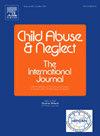Psychological maltreatment: Discovering its different subtypes and related developmental risk factors
IF 3.4
2区 心理学
Q1 FAMILY STUDIES
引用次数: 0
Abstract
Background
Psychological maltreatment (PM) is widely recognized as a particularly harmful form of child maltreatment. However, challenges in research persist, including limited empirical evidence on subtypes of PM and uncertainty whether its observed harmfulness stems from PM's inherent characteristics or its strong association with confounding developmental risk factors.
Objectives
This study aims to (a) investigate the dimensional structure of PM, particularly whether it can be grouped into the superordinate domains of psychological abuse and psychological neglect, and (b) examine the strength of PM's association with co-occurring developmental risk factors, such as adverse childhood experiences (ACE), compared to other types of child maltreatment.
Participants and settings
The study relies on a cross-sectional classroom-based survey in Switzerland with a sample of n = 1386 adolescents. A sub-sample of n = 727 adolescents (mean age = 14.48 years) who reported PM exposure above the sample mean was examined.
Methods
PM was assessed using the Computer Assisted Maltreatment Inventory, along with additional scales. Confirmatory factor analysis (CFA) was used to explore the dimensional structure of PM, and χ2 tests assessed associations with co-occurring developmental risk factors.
Results
Most PM subtypes were moderately to strongly correlated. Notable exceptions were corrupting and parentification, the latter being negatively correlated with other subtypes. Both CFA models showed only acceptable fits, with no improvement in fit for the second-order model with the domains psychological abuse and neglect. Adolescents exposed to PM had higher odds of experiencing co-occurring adversities, such as prolonged exposure and ACE, than victims of other types of child maltreatment.
Conclusion
These findings invite further reflection on how PM can be measured both validly and efficiently and how subtypes can be grouped into both domains. They also highlight that PM's close association with co-occurring developmental risk factors needs to be accounted for to accurately interpret PM's impact.
心理虐待:发现其不同亚型及其相关的发育危险因素
心理虐待(PM)被广泛认为是一种特别有害的儿童虐待形式。然而,研究中的挑战仍然存在,包括关于PM亚型的经验证据有限,以及不确定其观察到的危害是源于PM的固有特征还是与混杂的发育危险因素密切相关。目的:本研究旨在(a)调查心理虐待的维度结构,特别是它是否可以被归为心理虐待和心理忽视的上级领域,以及(b)与其他类型的儿童虐待相比,检验心理虐待与共同发生的发育风险因素(如不良童年经历(ACE))的关联强度。参与者和环境该研究基于瑞士的横断面课堂调查,样本为n = 1386名青少年。对报告PM暴露高于样本平均值的n = 727名青少年(平均年龄= 14.48岁)的子样本进行了检查。方法采用计算机辅助虐待量表及附加量表对spm进行评估。采用验证性因素分析(CFA)探讨PM的维度结构,并采用χ2检验评估其与共同发生的发育危险因素的相关性。结果大多数PM亚型具有中至强相关性。值得注意的例外是腐化和双亲化,后者与其他亚型呈负相关。两种CFA模型的拟合结果都是可以接受的,而二阶模型的心理虐待和忽视的拟合结果没有改善。与其他类型的儿童虐待相比,暴露于PM的青少年经历共同发生逆境的几率更高,例如长期暴露和ACE。这些发现引发了对如何有效和有效地测量PM以及如何将亚型分组到这两个领域的进一步思考。他们还强调,需要考虑PM与共同发生的发育风险因素的密切联系,以准确解释PM的影响。
本文章由计算机程序翻译,如有差异,请以英文原文为准。
求助全文
约1分钟内获得全文
求助全文
来源期刊

Child Abuse & Neglect
Multiple-
CiteScore
7.40
自引率
10.40%
发文量
397
期刊介绍:
Official Publication of the International Society for Prevention of Child Abuse and Neglect. Child Abuse & Neglect The International Journal, provides an international, multidisciplinary forum on all aspects of child abuse and neglect, with special emphasis on prevention and treatment; the scope extends further to all those aspects of life which either favor or hinder child development. While contributions will primarily be from the fields of psychology, psychiatry, social work, medicine, nursing, law enforcement, legislature, education, and anthropology, the Journal encourages the concerned lay individual and child-oriented advocate organizations to contribute.
 求助内容:
求助内容: 应助结果提醒方式:
应助结果提醒方式:


